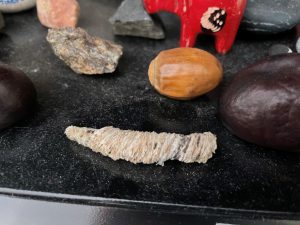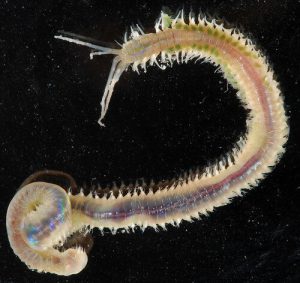
I keep a shelf full of little natural curiosities above my desk—shells, seed pods, sand dollars, and other keepsakes—but one of my favorites is the delicate casing of a decorator/plumed worm. Frequently found amidst the shells, sargassum, and other material washed up with the tide, tube-building decorator worms (Diopatra cupraea) are one of the more interesting and ornate beachcombing finds.

Created by a thin and vulnerable marine worm, the tube itself is essentially a shell-based suit of armor built by the worm from surrounding debris. The worm lives in a hole 1-3 feet deep in the sand, but if it emerges into the open water, it is vulnerable to predation by any passing fish or crab. Its ingenious solution is to use the sticky, polysaccharide-based mucus on its body to attach small pieces of shell, algae, sand, and broken coral to its body in concentric layers. The tubes work both as a hiding place and device for collecting food, peeking out of the sand like tiny periscopes.
The worm itself is described as “handsome” with bright red gills, iridescent body coloring, and yellow with green-speckled segmented parapodia. They resemble clear millipedes, with long antennae, large jaws (for ingesting copepods, larvae, and algae), and dozens of leg-like cilia. If the worms are eaten or abandon their tubes, the colorful shell-covered tubes break off or work out of the sand and end up on the shore. The next time you’re beachcombing, keep an eye out for these cool finds!
 1
1
